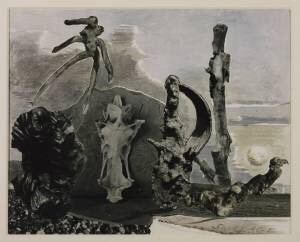Header Image: After the Battle, 1918 – Paul Nash
With another connection to World War One, I’ve asked Mr. Cake (and he kindly agreed) to share a piece on the wonderful artist Paul Nash.
Paul Nash is one of the foremost of British artists of the 20th Century as well as a major landscape painter. He was an official war artist in both World Wars, a leading exponent of Modernism in England , a founding member of the avant-garde group Unit One, whose members included Henry Moore, Barbara Hepworth, Ben Nicholson and the art critic, poet and writer Herbert Read, with whom he organised the International Surrealist Exhibition at the New Burlington Galleries, London in 1936.
Nash’s paintings and lithographs that he produced as official war artist during WWI are some of the most potent and visceral images of the devastated landscapes wrought by the infernal mechanised weapons of war. Justly famous are The Ypres Salient At Night and We Are Making A New World both of which are part of the Imperial War Museums permanent collection.
The war had left Paul Nash emotionally and artistically drained. In 1933 he formed the short-lived but important avant-garde group Unit One. He formed links across the Channel with the Surrealists, later commenting that he hadn’t found Surrealism, Surrealism had found him. Around this time he was based in the seaside town of Swanage on the Dorset coast, which led him to formulate his theory of ‘Seaside Surrealism’. He also began an affair with another exceptional Surrealist, Eileen Agar ( see Surrealist Women: Eileen Agar). Notable works of this period as the found objects collage Swanage and the painting Landscape In A Dream from 1936-1938.

At the start of WWII, Nash was again commissioned as a official war artist, this time with the Royal Air Force and the Air Ministry, which led to one of his most haunting paintings, Totes Meer (Dead Sea), (see below) based on Caspar David Friedrich’s The Sea of Ice, which was inspired by a field of crashed German aircraft in Cowley, Oxfordshire.
Paul Nash died in 1946 from heart failure resulting from his long term asthma. He is currently the subject of a major retrospective at the Tate until March 2017. Recently there has been a critical re-evaluation of his work, especially the important paintings from WWI and WWII, and he is generally considered the most important British painter between J.M.W Turner and Francis Bacon.



It is looking good good Doctor. Thank you for the invite, hopefully it works well in the context of your series.
LikeLiked by 1 person
Yes, this is just the kind of thing: history, art, poetry of the era. Thank you so much for writing this.
LikeLiked by 1 person
Real talent
LikeLiked by 2 people
Most definitely. Brilliant work.
LikeLiked by 1 person
Really wonderful art. The war influence of course is very visible. Interesting paintings too, you could look at them a long time and still not see something. I’d love to see an exhibit of his work. I love art but have never heard of him or his art. Thank you for this post Meg. It was enlightening.
LikeLiked by 1 person
I’m glad you enjoyed it. My friend Cake does a fantastic job with these art posts. I owe him many thanks for sharing with me!
LikeLiked by 1 person